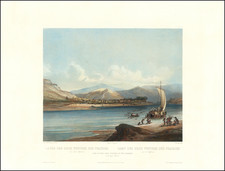This vivid chromolithograph captures the grandeur of a critical historical moment: Ferdinand and Isabella of Spain, at the height of their power, receiving Christopher Columbus upon his triumphant return in Barcelona on April 15, 1493. This late 19th-century production, issued by Kurz & Allison, uses anachronistic detail and allegorical representation to portray the meeting of the Old and New Worlds.
The historical significance of this artwork is manifold. The depicted event marks a turning point in global history, when Columbus's voyages opened a new era of transatlantic exploration, cultural exchange, and imperialism. Ferdinand and Isabella, the Catholic Monarchs, under whose auspices Columbus voyaged, here represent the political and religious authority of Europe, while the stylized representation of American Indians symbolizes the exoticism and mystery of the newly discovered territories.
The chromolithograph is an exemplary illustration of late 19th-century American print culture. Kurz & Allison, based in Chicago, were prominent publishers known for their colorful prints. Their work often portrayed historical events through a distinctly American lens, reflecting the nation's growing awareness of its place in the world. This print of Ferdinand and Isabella receiving Columbus, with its striking representation of American Indians, exemplifies their distinctive aesthetic and thematic concerns.
Finally, the chromolithographic medium itself carries a particular historical resonance. Popularized in the 19th century, chromolithography allowed for the mass production of colorful prints, democratizing art by making it accessible to a broader audience. This chromolithograph, with its vibrant colors and compelling subject matter, serves as a fascinating artifact of the era's cultural and technological developments.









![(North Dakota) Scalp Dance of the Minatarres [near Fort Clark, on the Missouri River]](https://storage.googleapis.com/raremaps/img/small/77692.jpg)
![(Yucatan) Indien contrebandier de l'interieur [Indian Smuggler from the Interior]](https://storage.googleapis.com/raremaps/img/small/86592.jpg)

![Gerardus Mercator . . . [and] . . . Iudocus Hondius . . .](https://storage.googleapis.com/raremaps/img/small/78439.jpg)
![(Aztec Tribute List) [Original watercolor showing tribute items paid to the Aztecs by subject towns] Mendoza Col. part 1s Lorenzana, Aglio 1, Vol 22...](https://storage.googleapis.com/raremaps/img/small/102321.jpg)
![[On Europe: Dutch Man, English Man, Russian Man, North American Man, and French Man] [Yoroppa no bu: Oranda-jin, Igirisu-jin, Furansu-jin, Kita-Amerika-jin, Roshia-jin]](https://storage.googleapis.com/raremaps/img/small/55553.jpg)